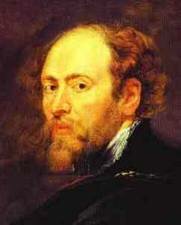 Piter Paul Rubens28.06.1577 Siegen, Germany - 30.05.1640 Antwerpen Art history: BaroqueCanvases of Piter Paul Rubens [118 canvases]
Biography of Piter Paul RubensPeter Paul Rubens was born into the family of a Calvinist who had to live in exile from Antwerp. On his father's death, Ruben’s mother returned to Antwerp in 1587, where he was brought up and educated in the Catholic faith. At the age of fourteen (1591) he entered the household of a Flemish princess as a page, and began to study painting first under Tobias Verhaecht, then under Adam van Noort, and then under Otho Venius. In 1598, he was accepted as master in the Lukas Guild, though continued to work in Venius’s workshop until 1600. In 1600, Rubens went to Italy. In Venice he was introduced to Duke Vincenzo Gonzaga and accepted his offer to join his court in Mantua. Rubens accompanied the duke on his travels to Florence and Rome; in Florence he happened to be present at the marriage of Marie de' Medici to Henry IV, King of France. Later his impressions would find reflection in the painting, devoted to the episode. In 1603, the duke sent him on a diplomatic mission to Spain. While in Italy, Rubens studied and copied Titian, Tintoretto, and Raphael, he also admired the works of his contemporaries, including Caravaggio and Carracci. During his Italian period he also produced some of his finest portraits at various princely Italian courts: The Equestrian Portrait of the Duke of Lerma (1603), Portrait of Marchesa Brigida Spinola Doria (c.1606). In 1608, he returned to Antwerp as a known and successful painter. In 1609, Rubens was appointed court painter to the Regent Albert and Isabella. He married Isabella Brant. In 1610, he built himself a large house and studio. During his Antwerp period, until 1622, he received a flood of commissions from the church, state and nobility. The Gobelin factory produced tapestries after his sketches, and engravers used his paintings, distributing the ‘Rubens style’ all over Europe. Among his best works are The Elevation of the Cross (the triptych). (1610-1611), The Descent from the Cross (the triptych). (1611-1614), The Union of Earth and Water (c.1618), Castor and Pollux Abduct the Daughters of Leukyppos (c.1618), The Battle of the Amazons (c.1618-1620), Perseus and Andromeda (c.1620-1621). His largest commission was in 1621 for a series of 21 paintings for Marie de’Medici, the Queen Dowager of France, widow of Henry IV. The paintings, describing Marie's life, were for her palace in Paris. It was not an easy work. The queen was far from being a beauty, her life was not full of interesting events, besides she was of bad temper: she had constantly quarreled with her deceased husband, Henry IV, wasted enormous sums of money, and bothered her son, Louis XIII, with constant advice so that at last he ordered her out of Paris. Rubens’s diplomatic skills were much at hand in fulfilling the order. He successfully managed it within three years to the great satisfaction of the customer. Between 1623 and 1631, Rubens traveled frequently on diplomatic missions, visiting London and Madrid, where he received peerages from both Charles I of England and Philip IV of Spain. Isabella Brant died in 1626; in 1630 Rubens married the 16-year-old Helene Fourment, who sat for many portraits and other works: Bathsheba at the Fountain. c.1635, The Fur Cloak (Helene Fourment). (1636-1639), The Three Graces. (c.1636-1638), Rubens, His Wife Helena Fourment, and Their Son Peter Paul. (c.1639). After the death of Archduchess Isabella he gradually withdrew from the court and bought castle Steen near Mecheln. His last big commission was the decoration of the Spanish King’s hunting lodge, Torre de la Parada near Madrid, which he designed but was no longer able to carry out himself. Rubens is often called Prince of Baroque painters. In his style he successfully united the features of Northern and Flemish art with those of Italy. His influence on the painters of his century was enormous, as it was on sculpture and architecture. He was a versatile genius and rivaled in inventive power the great minds of the Italian Renaissance. He was a humanist and classical archaeologist, a sumptuous designer of religious, historical and allegorical canvases and a supreme master in ‘pure’ landscape. Rubens was endlessly active. There are thousands of works by his hand, scattered through collections and museums across the world. The paintings amount to more than three thousand. He also gave the world the great number of pupils, the celebrated artists van Dyck, Jordaens, Snyders and Cornelis de Vos are among them.
You can find canvases of this artist in these museums:
|
Для красивого отображения Облака Quick Search artists |
|||||||||||||||